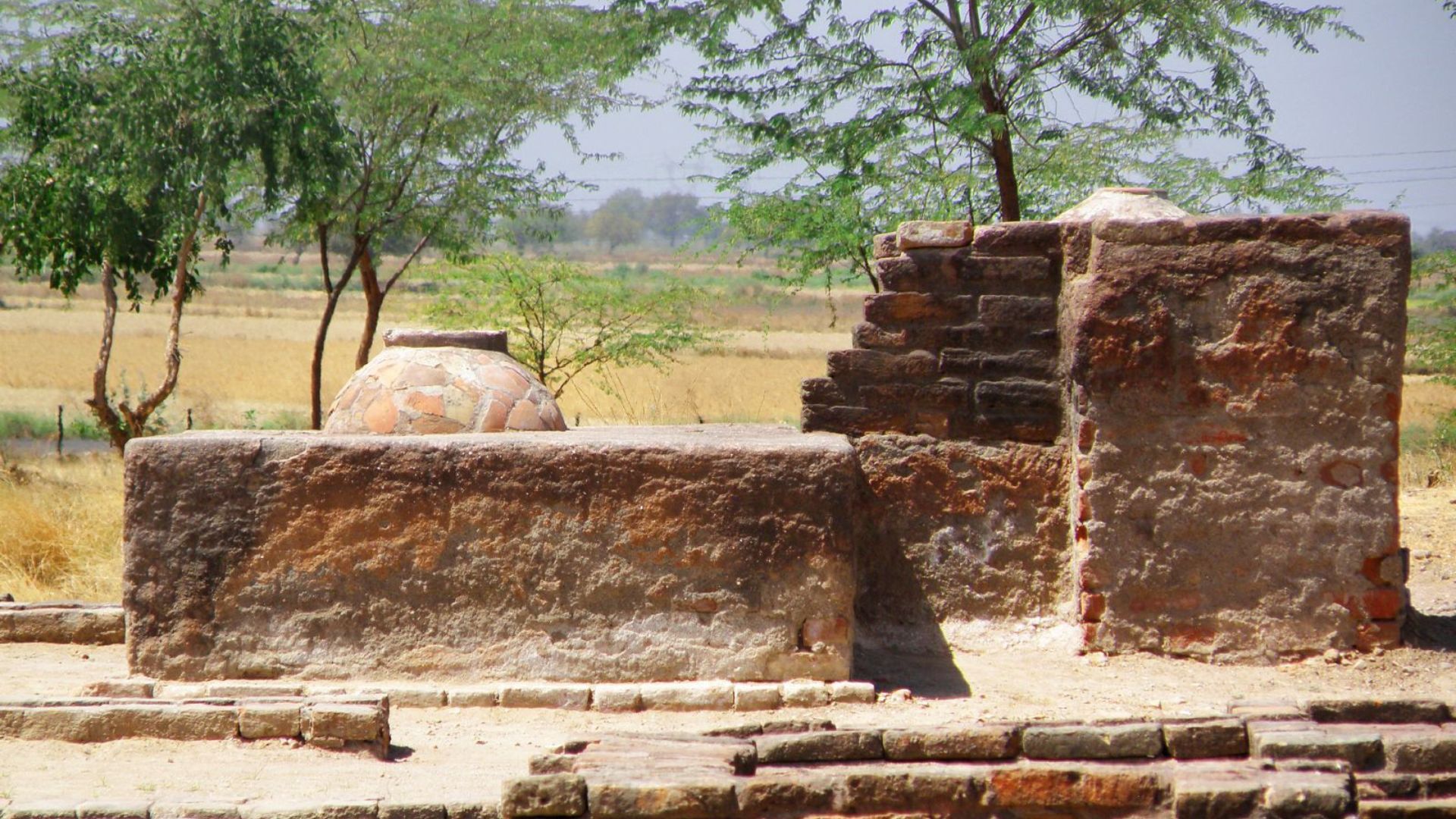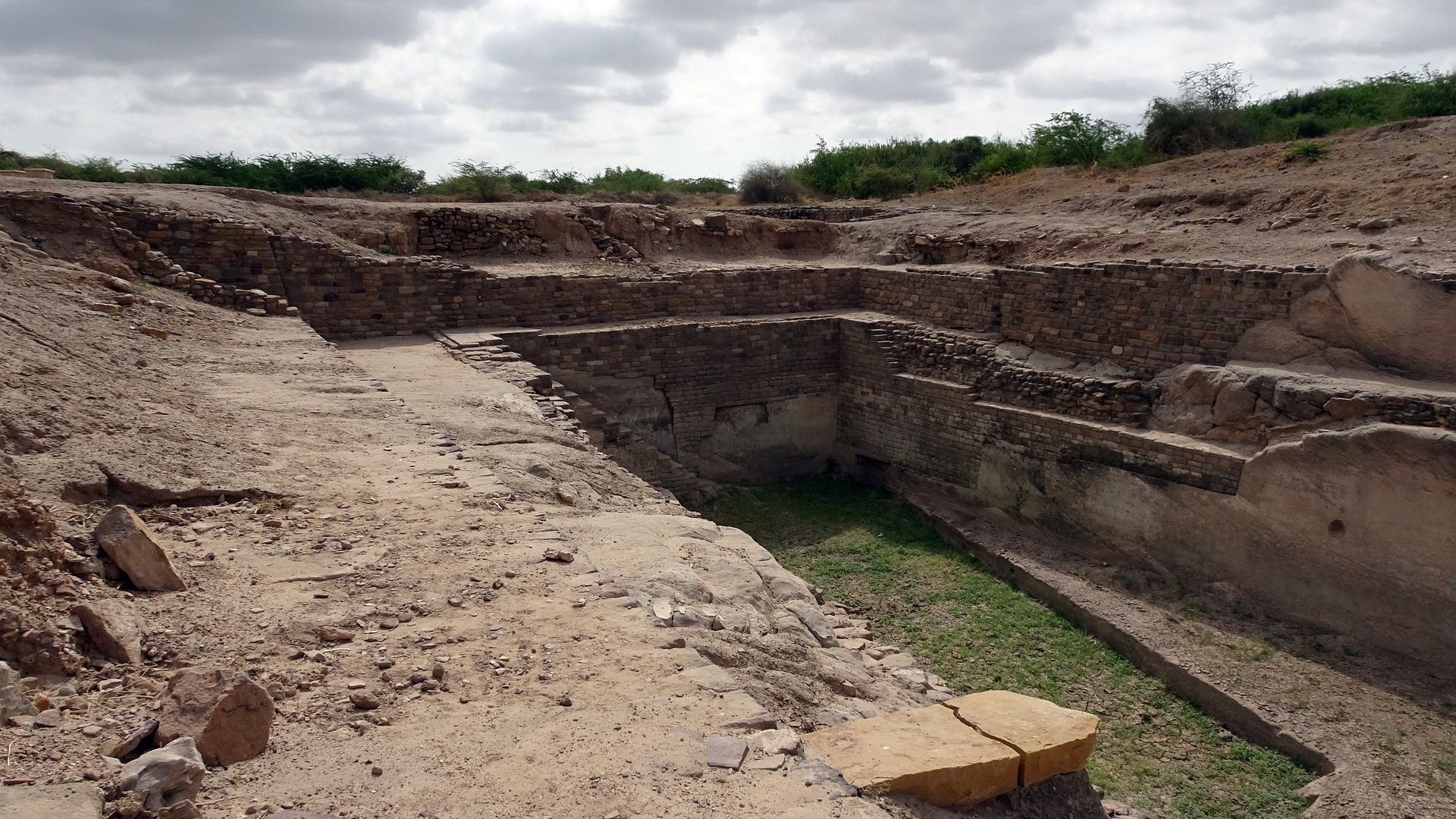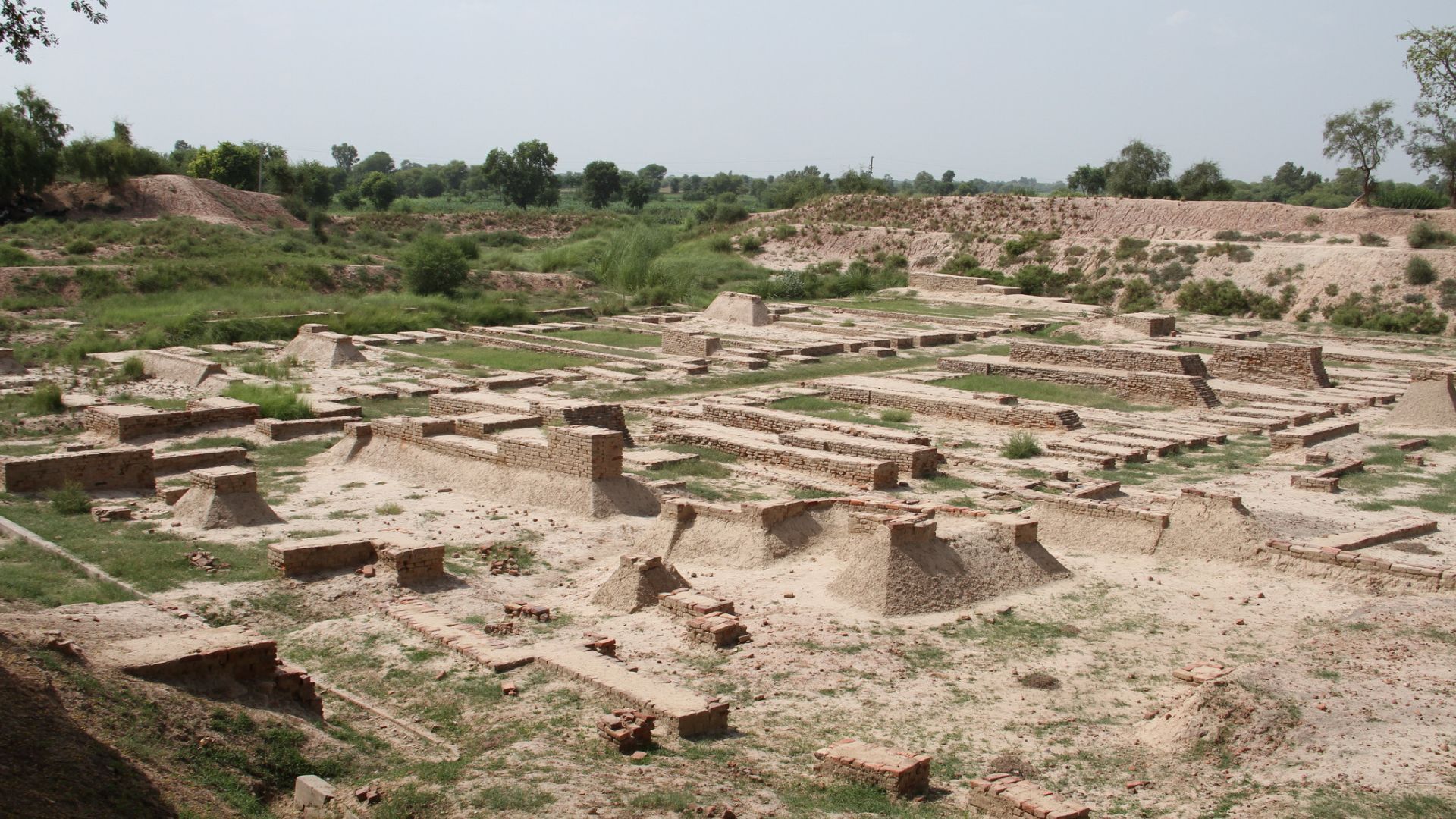
Among the oldest civilisations in the world, the Indus Valley Civilisation flourished in the Indus River valley from 3300 to 1300 BCE, alongside ancient Egypt and Mesopotamia. This ancient civilisation, also called the Harappan Civilisation, spanned across modern-day India, Pakistan and Afghanistan. Excavations at various sites across these countries offer valuable insights into the complex urban society that thrived thousands of years ago.
Archaeological discoveries here have shown that the people were skilled in agriculture, pottery and metalwork, and had developed systems of reading and writing. They also had well-organised systems of housing, plumbing and intricate social networks, all of which have been deduced from the evidence unearthed across these sites. The Indus Valley Civilisation was also an important trade centre that exchanged textiles, metals and precious stones with Mesopotamia, Persia and Central Asia.
Today, remnants of this ancient civilisation can be found across South and Central Asia, primarily in India and Pakistan, and one site in Afghanistan. Here are some destinations where you can explore traces of the Indus Valley Civilisation.
Places to explore the Indus Valley Civilisation in South Asia
India
Gujarat
Gujarat, a state steeped in culture and history, is home to some 200 sites of the Indus Valley Civilisation. Travellers can visit sites like Lothal, Dholavira and Surkotada to witness the heritage of this ancient civilisation.
Lothal

Also discovered here were canals and a market, indicating that it was a well-established town. The site also has the Archaeological Museum, which showcases a fascinating range of artefacts, including jewellery, seals, pottery and objects of daily use. The complexity of the site’s map and the artefacts hint at extensive trade connections with Mesopotamia, Persia and Egypt.
Dholavira

This UNESCO World Heritage site is located in Kutch, Gujarat. Larger than Lothal, this site dates back some 4,500 years, offering valuable insights into the Harappan water conservation system, one of the earliest and most well-planned systems of its kind. Dholavira also houses what might be the world’s first signboard, according to Gujarat Tourism.
The site, which spreads over 100 hectares, also showcases the seven stages of the Indus Valley Civilisation, from its development to its eventual end. Evidence suggests that Dholavira was temporarily abandoned at its peak, with settlers opting for a simpler, less urbanised lifestyle, as hints of this transition have been found at the site.
Shop the best travel experiences here
Surkotada
Surkotada, a small site near Bhuj, is a 3.5-acre space discovered between 1964 and 1968. At that time, it had an average height of five to eight metres from east to west. Rubble fortifications and an adjacent lower area containing Harappan and other pottery and antiquities are suggestive of its connection to the Indus Valley Civilisation.
According to Gujarat Tourism, Harappans arrived at this site around 2300 BCE. They built a fortified citadel and a residential annexe that had houses with bathrooms and drainage systems. A heavy copper celt, chisel and Harappa beads were also discovered from this site.
Rajasthan
Kalibangan

Kalibangan, which literally translates to ‘black bangles’, is located in Hanumangarh, in the northern region of Rajasthan. The site is an invaluable part of the Indus Valley Civilisation and one of the few such sites in India. According to the Rajasthan Foundation, this area was established as a planned city in 2900 BCE. Discovered by Italian Indologist Luigi Pio Tessitori, remains of pre-Harappan and Harappan cultures have been found here, showcasing the transition from the former to the latter period.
The archaeological findings at Kalibangan include copper artefacts, pottery (including cooking pots) and the Civilisation’s seals. Remains of an ancient cemetery have also been uncovered at the site. It’s noteworthy that Kalibangan does not display signs of baked bricks and orderly layout of houses and drainage systems seen at later Harappan sites. The Archaeological Museum here houses several artefacts from the region and is a must-visit for history buffs.
Haryana
Banawali

Banawali, located in the Fatehabad district of Haryana, lies on the dry bed of the ancient Saraswati River. Excavations at this site have revealed evidence of three distinct periods: pre or early Harappan, Harappan and Bara (post-Harappan). The site was uncovered by Dr RS Bhist of the Archaeological Survey of India.
According to the Haryana Tourism website, the pre-Harappan existence of Banawali is characterised by the presence of well-planned houses and fortified walls made of moulded bricks. Adding to it is the discovery of motifs painted with white pigment, the use of which gradually declined. The transition to the Harappan period is marked by the discovery of finer pottery reminiscent of Harappan ceramics, including jars, basins, troughs, as well as semi-precious stones, terracotta, steatite, clay bangles and copper artefacts.
The Harappan Civilisation at Banawali, which existed between 2400 BCE and 1900 BCE, is characterised by a well-planned fortified township, red ware decorated with animal and floral designs, perforated jars, ‘S’-shaped jars, beakers, basins and various other artefacts. The subsequent Bara Culture, a post-Harappan period, is largely distinguished by its robust pottery made from fine clay and baked with a glossy finish.
Rakhigarhi
Among the five biggest townships of the Indus Valley Civilisation in India, Rakhigarhi is located in Haryana. Archaeological findings at this site reveal the mature Harappan phase, characterised by a well-planned township made of mud-brick and burnt-brick houses, and an efficient drainage system. Ceramic artefacts, such as redware, jars, bowls, vases, goblets and handis, have been found here. Evidence of animal sacrificial pits and brick-lined triangular and circular fire altars has also been unearthed, as documented by the Haryana Tourism website.
Another important artefact discovered in Rakhigarhi is the cylindrical seal with five Harappan characters on one side and an alligator symbol on the other side. Some other antiques dug out from this site include blades, bangles of terracotta and shell, beads made with semi-precious stones, copper objects, animal figurines, a toy cart frame, terracotta wheels and sealings, to name a few.
Punjab
Ropar (Rupnagar)
Ropar, located on the banks of river Sutlej, is home to archaeological remains dating back to the Indus Valley Civilisation. These relics are displayed at the Archaeological Museum, which was opened to the public in 1998. Ropar was the first site excavated in Independent India.
The site has revealed a cultural sequence spanning from the Harappan era to the medieval age. Exhibits here include those from the Harappan Civilisation and Saka, Kushana and Gupta periods. Some notable artefacts include painted grey ware, the Vina Vadini sculpture (depicting a lady playing the veena), steatite seals, copper and bronze implements, ring stones, and gold coins from the Chandragupta era, according to the official website. The museum also provides glimpses of protected monuments in Punjab, Haryana, Himachal Pradesh and other World Heritage monuments.
Tamil Nadu
In July 2023, researchers found evidence of a connection between Tamil Nadu and the Indus Valley Civilisation. These findings, situated at Sivakalai in Tuticorin, Tamil Nadu, date back to 2,500 BCE-3,000 BCE, as reported by The Times of India.
These discoveries point to the existence of an Iron Age civilisation in Tamil Nadu that runs parallel to the Indus Valley Civilisation. Ongoing studies aim to identify the graffiti marks found in Tamil Nadu, with the goal of establishing a link with the Indus script, which hasn’t been deciphered to this day.
Pakistan
Punjab
Harappa

Some of the major sites of the Indus Valley Civilisation are located in present-day Pakistan, including Harappa. The site dates back to the 3rd millennium BCE and is a must-visit for history buffs looking to learn about one of the earliest civilisations in the world.
This site houses the Eid Gah Masjid, believed to have been constructed using bricks from Harappa. The Citadel, which dates back to 2200 BCE, offers a glimpse of the well-planned city’s infrastructure, including its brick-lined drains, walls, and a sophisticated sewage system, among other things.
Visit the Great Granary, an impressive structure with underground storage rooms for grains and other food items, and go to the Great Bath, an iconic rectangular pool surrounded by steps, likely used for ritual bathing or religious ceremonies. Apart from the Harappan ruins, don’t miss the famous “dancing girl” statue.
Also, be sure to visit the Harappa Museum, which houses artefacts excavated from the site, including a woman’s skeleton with ornaments and pottery items.
Sindh
Mohenjo Daro

Mohenjo Daro (or Moenjo Daro) literally translates to ‘mound of dead men’ or ‘mound of Mohan’ and is among the earliest cities of the Indus Valley Civilisation. Located approximately 31 km from Larkana, this archaeological site is in the Sindh province of Pakistan. What makes Mohenjo Daro an important site in the study of the ancient world is the evidence of trade routes between ancient Egyptian and Mesopotamian civilisations found here.
Common features found in cities of the Indus Valley Civilisation, such as the Citadel and a public bath, are also seen in Mohenjo Daro. The Citadel housed public baths, a marketplace, large residential blocks and an assembly hall.
Structures like the Great Granary and the Great Bath, believed to be the first public water tank of the ancient world, are a must-see. Also, visit the museum onsite that houses giant murals and recreations of artefacts, including the famed Dancing Girl statue, as well as ancient seals used in the city.
Chanhudaro
Chanhudaro is approximately 130 km from Mohenjo Daro and showcases influences of both Mohenjo Daro and Harappa. This site is known for the discovery of beads, seal-amulets and pottery, and is believed to have been an important centre for the production of carnelian beads.
Chanhudaro, too, showcases the presence of a well-planned city by the river, with proper drainage systems and the use of baked-mud bricks. Excavations have also revealed evidence of the Jhukar culture and Jhukar pottery. Polychrome pottery, associated with the later Harappan period, has also been discovered here.
Balochistan
Mehrgarh

Another must-visit site of the Indus Valley Civilisation in Pakistan is Merhgarh. Located in Balochistan, the site dates back to 7000 BCE, according to CNBC TV 18, and it offers important insights into one of the earliest civilisations of the world.
Discovered by French archaeologist Jean-Francois Jarrige in the 1970s, Merhgarh is believed to have been a bustling city and an important centre for trade and agriculture. Excavations at the site have also revealed evidence of pottery, metalwork and weaving.
The site also showcases well-preserved houses, granaries, workshops, potteries, and artefacts such as jewellery and decorative items. Agriculture here included growing wheat, barley and peas, as well as domesticating animals such as sheep and goats.
Afghanistan
Shortugai
Shortugai is located in the Darqad district of Afghanistan and is believed to have been an important centre of trade in the ancient world. The mounds found here are close to the Oxus (Amu Darya) river. Evidence of a canal system, along with bricks and mortar walls, indicates that it was a settled city. Artefacts such as carnelian beads, pottery and bronze items reveal that the people practised metalwork and other crafts that were key to the civilisation.
(Hero and Featured Image credit: Jawwad Ali/Shutterstock)
Related: These UNESCO World Heritage Sites In South India Let You Explore India’s Rich Past
Frequently Asked Questions (FAQs)
– What are the notable sites of the Indus Valley Civilisation?
In India, places such as Lothal, Dholavira, Kalimabgan, Surkotada and Banawali are some of the must-visit sites. In Pakistan, you must visit Harappa and Mohenjo Daro, while in Afghanistan, Shortugai is a must-see.
– Is Indus Valley Civilisation a tourist place?
Many places that were once part of the Indus Valley Civilisation are now popular tourist destinations.
– Which is the largest site in the Indus Valley Civilisation?
While Harappa and Mohenjo Daro are believed to be the largest sites in the Civilisation, an article in The Hindu names Rakhigarhi in Haryana as the largest site.
– Which port from the Indus Valley Civilisation is the most famous?
Lothal, located in Gujarat, India, is among the most popular ports. It is also believed to be the first man-made port in the world.
– What are the five major Harappan cities?
The five popular Harappan Civilisation cities are Harappa, Mohenjo Daro, Ganweriwala, Dholavira and Rakhigarhi.
– What are the two largest cities in the Indus Valley Civilisation?
Harappa and Mohenjo Daro are believed to be the largest cities of the civilisation. However, Rakhigarhi is also recognised as the largest site of the Indus Valley Civilisation.














